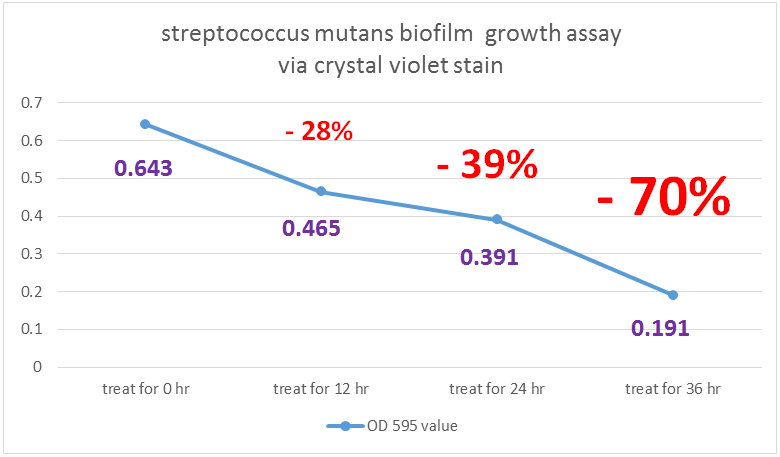Difference between revisions of "Part:BBa K1510904"
| Line 1: | Line 1: | ||
| − | |||
__NOTOC__ | __NOTOC__ | ||
<partinfo>BBa_K1510904 short</partinfo> | <partinfo>BBa_K1510904 short</partinfo> | ||
we use truncated lysostaphin coding sequence(designed by HIT-Harbin 2012 igem team) to reach our goal deplete biofilm formed by streptococcus mutans. YebF,a signal protein, would be secreted outside E.coli to make protein works more accurately. | we use truncated lysostaphin coding sequence(designed by HIT-Harbin 2012 igem team) to reach our goal deplete biofilm formed by streptococcus mutans. YebF,a signal protein, would be secreted outside E.coli to make protein works more accurately. | ||
| + | |||
| + | experiment1: using Hoperfusion to do biofilm growth assay. | ||
| + | |||
| + | 1.S. mutans growing for 36 hr (control) OD = 0.643 | ||
| + | |||
| + | 2.S. mutans growing for 36 hr and treat with our modified E. coli for 12hr OD =0.465 | ||
| + | |||
| + | 3.S. mutans growing for 36 hr and treat with our modified E. coli for 24hr OD =0.391 | ||
| + | |||
| + | 4.S. mutans growing for 36 hr and treat with our modified E. coli for 36hr OD =0.191 | ||
| + | |||
| + | [[file:NYMU_antibiofilm picture1.jpg]] | ||
| + | Indicated from the graph, we could clearly see that treating our modified E. coli (transformed by Dispersin B circuit and lysostephin circuit ) have a negative impact on biofilm growth of Streptococcus mutans. As a result, we have confidence that our modified E. coli have ability to treat or influence biofilm formation. | ||
| + | |||
| + | experiment2: 24well to test biofilm decrease | ||
| + | To test whether our modified e-coli(transformed with dispersin B and lysostephin circuit ) has influence on biofilm growth, we designed function test under two situation in 24 well. | ||
| + | |||
| + | First one is to co-culture streptococcus mutans and modified e-coli for24hr and do biofilm growth assay. The other one is to culture streptococcus mutans for 12hr and then treat with modified e-coli for 12hr and do biofilm growth assay. Also, we compare the streptococcus mutans growth situation in BHI solution with or without sucrose. We used crystal violet stain to do biofilm grow assay. | ||
| + | [[file:NYMU_antibiofilm picture2.jpg] | ||
| + | Indicated from the table, we could conclude that under no sucrose, modified e-coli has a great effect on decreasing biofilm formation. Co-culture decreasing rate is up to 64.2% and treat decreasing rate is 51.9% .On the other hand, solution with sucrose will has the bad impact on depleting biofilm, causing low decreasing rate. Overall, we could dedicate that modified e-coli has a good effect on decreasing biofilm formation or depleting biofilm.[[file:NYMU_antibiofilm picture3.jpg] | ||
<!-- Add more about the biology of this part here | <!-- Add more about the biology of this part here | ||
Revision as of 21:32, 28 October 2014
Truncated lysostaphin coding circuit
we use truncated lysostaphin coding sequence(designed by HIT-Harbin 2012 igem team) to reach our goal deplete biofilm formed by streptococcus mutans. YebF,a signal protein, would be secreted outside E.coli to make protein works more accurately.
experiment1: using Hoperfusion to do biofilm growth assay.
1.S. mutans growing for 36 hr (control) OD = 0.643
2.S. mutans growing for 36 hr and treat with our modified E. coli for 12hr OD =0.465
3.S. mutans growing for 36 hr and treat with our modified E. coli for 24hr OD =0.391
4.S. mutans growing for 36 hr and treat with our modified E. coli for 36hr OD =0.191
 Indicated from the graph, we could clearly see that treating our modified E. coli (transformed by Dispersin B circuit and lysostephin circuit ) have a negative impact on biofilm growth of Streptococcus mutans. As a result, we have confidence that our modified E. coli have ability to treat or influence biofilm formation.
Indicated from the graph, we could clearly see that treating our modified E. coli (transformed by Dispersin B circuit and lysostephin circuit ) have a negative impact on biofilm growth of Streptococcus mutans. As a result, we have confidence that our modified E. coli have ability to treat or influence biofilm formation.
experiment2: 24well to test biofilm decrease To test whether our modified e-coli(transformed with dispersin B and lysostephin circuit ) has influence on biofilm growth, we designed function test under two situation in 24 well.
First one is to co-culture streptococcus mutans and modified e-coli for24hr and do biofilm growth assay. The other one is to culture streptococcus mutans for 12hr and then treat with modified e-coli for 12hr and do biofilm growth assay. Also, we compare the streptococcus mutans growth situation in BHI solution with or without sucrose. We used crystal violet stain to do biofilm grow assay. [[file:NYMU_antibiofilm picture2.jpg] Indicated from the table, we could conclude that under no sucrose, modified e-coli has a great effect on decreasing biofilm formation. Co-culture decreasing rate is up to 64.2% and treat decreasing rate is 51.9% .On the other hand, solution with sucrose will has the bad impact on depleting biofilm, causing low decreasing rate. Overall, we could dedicate that modified e-coli has a good effect on decreasing biofilm formation or depleting biofilm.[[file:NYMU_antibiofilm picture3.jpg]
Sequence and Features
- 10COMPATIBLE WITH RFC[10]
- 12INCOMPATIBLE WITH RFC[12]Illegal NheI site found at 7
Illegal NheI site found at 30
Illegal NheI site found at 50
Illegal NheI site found at 73
Illegal NheI site found at 1092 - 21INCOMPATIBLE WITH RFC[21]Illegal BglII site found at 202
- 23COMPATIBLE WITH RFC[23]
- 25COMPATIBLE WITH RFC[25]
- 1000COMPATIBLE WITH RFC[1000]
